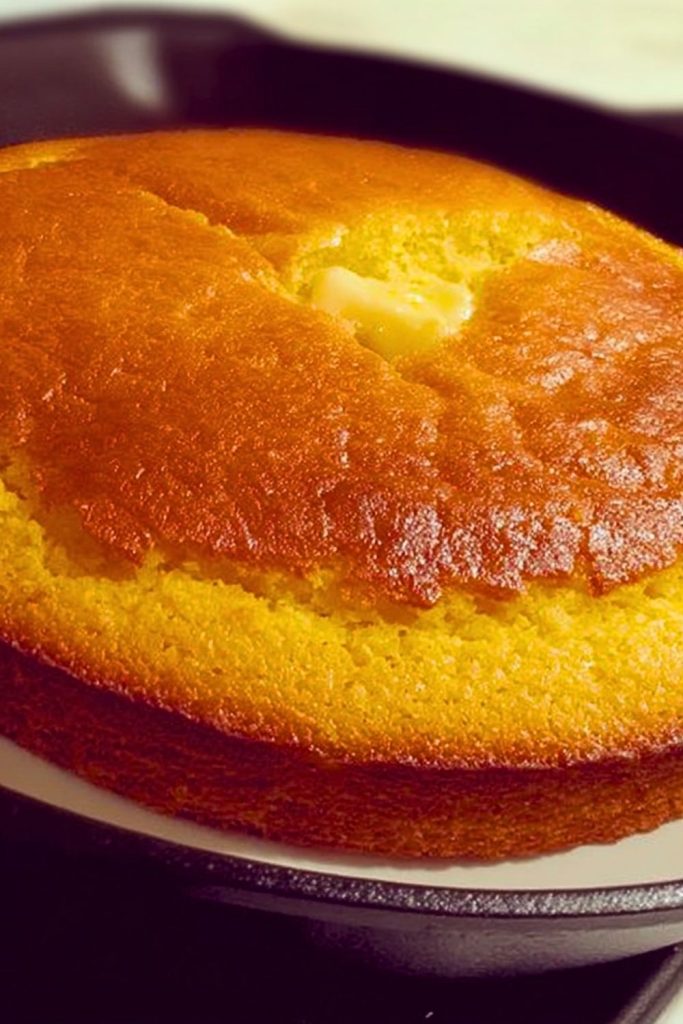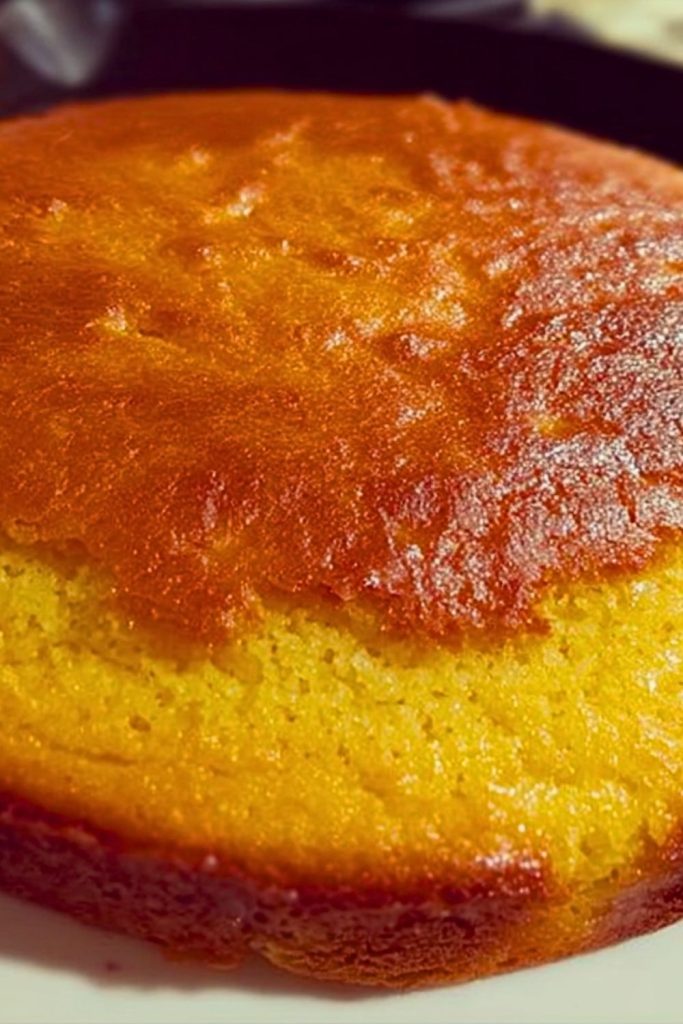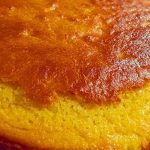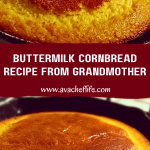There’s something unmistakably comforting about the smell of fresh cornbread baking in a cast iron skillet. For me, this Buttermilk Cornbread Recipe from Grandmother isn’t just a side dish — it’s a memory wrapped in golden crust. My grandmother would pull this out of the oven, slice it into thick wedges, and serve it warm with a pat of butter that melted on contact. It wasn’t fancy, but it never needed to be. The flavor spoke for itself — slightly tangy, lightly sweet, and deeply nostalgic.

I’ve carried this recipe with me over the years, adjusting nothing because it’s already perfect. It has that crisp, buttery edge only a hot skillet can deliver, and a tender, moist center thanks to real buttermilk. Whether paired with a hearty bowl of chili, a roast chicken dinner, or just enjoyed on its own with honey or jam, this cornbread never disappoints. It’s the kind of recipe that turns a simple meal into a cherished ritual.
Why You’ll Love This Buttermilk Cornbread Recipe
- Golden edges with a soft, tender crumb — the best of both worlds.
- True Southern flavor thanks to real buttermilk and yellow cornmeal.
- Quick and easy — one bowl, one skillet, one unforgettable bake.
- Versatile enough for sweet or savory applications.
- Family-approved and steeped in tradition, making it perfect for holidays or weeknight dinners.
What Kind of Cornmeal Should I Use for Buttermilk Cornbread?
For that authentic Southern flavor and texture, stone-ground yellow cornmeal is the way to go. It brings a slightly coarse texture and bold corn flavor that’s essential to old-fashioned cornbread. Avoid using cornmeal mix or self-rising cornmeal unless the recipe is specifically designed for it—those typically include added leavening and salt, which can throw off the balance.
If you only have white cornmeal, it’ll work in a pinch, but the flavor and color will be a bit milder. I always stick to yellow for that rich color and deeper flavor that reminds me of my grandmother’s kitchen.
Options for Substitutions
While I’m loyal to the original version, here are some swaps you can make if needed:
- Buttermilk Substitute: No buttermilk? Mix 1 tablespoon of white vinegar or lemon juice with 1 cup of milk. Let it sit for 5–10 minutes before using.
- Butter Alternative: You can use melted coconut oil or vegetable oil if you’re out of butter, but it will slightly alter the flavor.
- Egg Replacement: For egg-free versions, a flax egg (1 tbsp ground flaxseed + 3 tbsp water) can help bind the batter.
- Sweetness Control: My grandmother’s recipe is lightly sweetened. You can reduce the sugar or leave it out altogether if you prefer savory.
- Gluten-Free Option: Swap the all-purpose flour for a 1:1 gluten-free flour blend to make it gluten-friendly without sacrificing texture.
These changes will slightly shift the final result, but the soul of the cornbread will remain intact.
Ingredients for This Buttermilk Cornbread Recipe
- Yellow Cornmeal – This is the heart of the cornbread. It gives that signature grainy texture and rich corn flavor that defines the dish.
- All-Purpose Flour – A small amount helps give the cornbread structure and prevents it from being too crumbly.
- Granulated Sugar – Just enough to balance the tang of the buttermilk without making it overly sweet.
- Baking Powder – Adds lift, giving the cornbread a light and fluffy texture.
- Baking Soda – Works with the buttermilk’s acidity to boost the rise and create a tender crumb.
- Salt – Enhances all the other flavors and keeps the cornbread from tasting flat.
- Buttermilk – The star of this recipe, adding moisture, tang, and helping create that perfect texture.
- Eggs – Bind everything together and give the cornbread some richness.
- Melted Butter – Adds richness and that irresistible buttery flavor, especially when some is poured into the skillet before baking for a golden crust.

Step 1: Preheat the Oven and Prepare the Skillet
Start by preheating your oven to 425°F (220°C). Place a well-seasoned cast iron skillet (usually 9-inch) in the oven as it heats. This helps build that crispy, golden crust we all love.
Step 2: Mix the Dry Ingredients
In a large mixing bowl, whisk together the yellow cornmeal, all-purpose flour, sugar, baking powder, baking soda, and salt. This ensures everything is evenly distributed before the wet ingredients go in.
Step 3: Combine Wet Ingredients
In a separate bowl, whisk together the buttermilk, eggs, and melted butter until well blended. Make sure your butter has cooled slightly before mixing, so it doesn’t scramble the eggs.
Step 4: Bring It All Together
Pour the wet mixture into the dry ingredients. Gently stir with a wooden spoon or spatula just until combined. Don’t overmix—it’s okay if it looks slightly lumpy. That’s what keeps it tender.
Step 5: Pour Into the Hot Skillet
Carefully remove the hot skillet from the oven and add a little bit of butter or oil to coat the bottom. Pour the batter into the skillet—it should sizzle as it hits the pan. That’s a good sign!
Step 6: Bake Until Golden
Place the skillet back in the oven and bake for 20–25 minutes, or until the top is golden brown and a toothpick inserted into the center comes out clean. Let it cool for a few minutes before slicing.
How Long to Cook the Buttermilk Cornbread
The buttermilk cornbread bakes at 425°F (220°C) for about 20 to 25 minutes. You’ll know it’s done when the top is deeply golden and the edges have pulled slightly from the sides of the skillet. A toothpick inserted in the center should come out clean or with just a few moist crumbs.
Let it rest for 5 to 10 minutes before slicing — it finishes setting during that time, and cutting too early can make it fall apart.
Tips for Perfect Buttermilk Cornbread
- Preheat the skillet – This creates that irresistibly crispy bottom and edges.
- Don’t overmix the batter – Mix until just combined to keep the crumb tender.
- Use full-fat buttermilk – It brings more flavor and moisture than low-fat versions.
- Let your ingredients come to room temperature – This helps everything blend smoothly and gives the batter a better rise.
- Add a touch of honey or chopped jalapeños if you want to experiment with sweetness or spice without changing the base recipe.
- Cut with a sharp knife for clean slices and avoid dragging a butter knife, which can crumble the loaf.
Watch Out for These Mistakes While Cooking
- Skipping the skillet preheat: A cold skillet won’t give you that signature crispy crust. Make sure it’s piping hot before pouring in the batter.
- Using the wrong cornmeal: Don’t use cornmeal mix or super-fine cornmeal. Stone-ground yellow cornmeal gives the best flavor and texture.
- Overbaking: Cornbread can dry out quickly if you leave it in too long. Start checking around 20 minutes.
- Overmixing the batter: Stir just until everything comes together. Overmixing can make the cornbread dense.
- Not greasing the pan: Even a seasoned skillet needs a little butter or oil before pouring in the batter to prevent sticking.
- Cutting too soon: Let it rest for a few minutes so it can finish setting, or you risk a crumbly mess.
What to Serve With Buttermilk Cornbread?
Chili
A classic pairing. The slightly sweet, buttery cornbread is the perfect match for a spicy, hearty bowl of chili.
Collard Greens
Serve with slow-cooked greens and a splash of vinegar for a Southern-style comfort plate.
Fried Chicken
Crispy fried chicken and warm cornbread? It doesn’t get more soul-satisfying than that.
BBQ Pulled Pork
Use cornbread as a side or even to make sliders with pulled pork and slaw.
Soup or Stew
Dunk it in a bowl of beef stew, vegetable soup, or gumbo for a hearty meal.
Honey Butter or Jam
Enjoy it on its own with a generous smear of honey butter, fruit preserves, or even maple syrup.
Eggs and Bacon
Turn it into a breakfast side — slice it, toast it lightly, and serve alongside scrambled eggs and crispy bacon.
Black-Eyed Peas
A traditional New Year’s combo, but great any time of year with a little hot sauce and cornbread on the side.
Storage Instructions
Buttermilk cornbread stores beautifully — and honestly, it tastes just as good the next day.
- Room Temperature: If you’ll eat it within 1–2 days, wrap the cornbread tightly in foil or place it in an airtight container. Keep it in a cool, dry spot on the counter.
- Refrigerator: For longer storage (up to 5 days), keep it in the fridge. Just make sure it’s tightly wrapped to prevent it from drying out.
- Freezer: Yes, you can freeze it! Wrap individual slices in plastic wrap and then place them in a freezer-safe bag or container. It will keep well for up to 2 months. To reheat, let it thaw and then warm in the oven or microwave.
Pro tip: Wrap it in a slightly damp paper towel before microwaving to help retain moisture.
Estimated Nutrition (per serving – based on 8 servings)
- Calories: ~220
- Total Fat: 10g
- Saturated Fat: 6g
- Cholesterol: 55mg
- Sodium: 310mg
- Total Carbohydrates: 28g
- Dietary Fiber: 2g
- Sugars: 4g
- Protein: 5g
Please note: These values are approximate and may vary depending on the exact brands and measurements used.
Frequently Asked Questions
How do I know when the cornbread is done?
It’s ready when the top is golden brown, the edges are slightly pulling away from the skillet, and a toothpick inserted in the center comes out clean or with a few moist crumbs.
Can I use milk instead of buttermilk?
You can, but the texture and flavor won’t be quite the same. Buttermilk adds moisture and a slight tang. If you don’t have any, make a quick substitute by adding 1 tablespoon of vinegar or lemon juice to 1 cup of milk.
Why is my cornbread dry?
Overbaking or using too much flour can dry it out. Make sure to measure ingredients accurately and check for doneness starting at 20 minutes.
Can I make this recipe without a cast iron skillet?
Absolutely. You can use a metal or glass baking dish, but you won’t get that same crispy crust. If using another pan, reduce the oven temp by 25°F.
Can I make this ahead of time?
Yes! You can bake it a day ahead. Store it tightly wrapped and reheat in the oven at 300°F for about 10 minutes to bring back the warmth and texture.
How do I reheat cornbread without drying it out?
Wrap slices in foil or a damp paper towel and reheat in the oven or microwave. The moisture helps keep it soft.
Is this recipe gluten-free?
Not by default, but you can swap the all-purpose flour with a 1:1 gluten-free blend. Make sure your cornmeal is gluten-free too.
Can I add cheese or jalapeños to the batter?
Absolutely! Sharp cheddar and diced jalapeños are fantastic add-ins. Stir them in right before baking for extra flavor and kick.
Conclusion
This Buttermilk Cornbread Recipe from Grandmother isn’t just a nostalgic side — it’s a timeless staple that brings warmth and comfort to any table. Whether you’re serving it alongside a hearty meal or sneaking a slice for breakfast, it’s always a welcome addition. With a golden crust, moist crumb, and just the right balance of savory and sweet, this cornbread is a recipe you’ll find yourself coming back to again and again.

Buttermilk Cornbread Recipe from Grandmother
- Prep Time: 10 minutes
- Cook Time: 25 minutes
- Total Time: 35 minutes
- Yield: 8 servings
- Category: Side Dish
- Method: Baked
- Cuisine: Southern
- Diet: Vegetarian
Description
Craving something warm, golden, and made with love? This Buttermilk Cornbread Recipe from Grandmother is the ultimate comfort food. It’s everything you want in a quick bread: crispy on the edges, moist in the middle, and full of that old-fashioned Southern charm. Made with real buttermilk and yellow cornmeal, it’s the perfect companion for chili, soups, BBQ, or a simple breakfast with butter and jam. Whether you’re hunting for easy dinner ideas, a quick breakfast, or a classic side for your holiday table, this easy recipe will quickly become a family favorite.
Ingredients
1 cup yellow cornmeal
1 cup all-purpose flour
3 tablespoons granulated sugar
1 tablespoon baking powder
1/2 teaspoon baking soda
1/2 teaspoon salt
1 1/4 cups buttermilk
2 large eggs
1/4 cup melted butter (plus 1 tablespoon for skillet)
Instructions
1. Preheat your oven to 425°F (220°C) and place a cast iron skillet inside to heat up.
2. In a large bowl, whisk together the cornmeal, flour, sugar, baking powder, baking soda, and salt.
3. In a separate bowl, whisk the buttermilk, eggs, and melted butter until smooth.
4. Pour the wet ingredients into the dry ingredients and stir just until combined. Do not overmix.
5. Carefully remove the hot skillet from the oven and swirl 1 tablespoon of butter to coat the bottom.
6. Immediately pour the batter into the hot skillet. It should sizzle slightly.
7. Return the skillet to the oven and bake for 20 to 25 minutes until golden brown and a toothpick comes out clean.
8. Let the cornbread rest for 5 to 10 minutes before slicing and serving.
Notes
For best results, use stone-ground yellow cornmeal for flavor and texture.
Don’t skip preheating the skillet — it’s what creates the crispy bottom crust.
Want to add a twist? Stir in shredded cheddar, corn kernels, or diced jalapeños before baking.
Nutrition
- Serving Size: 1 slice
- Calories: 220
- Sugar: 4g
- Sodium: 310mg
- Fat: 10g
- Saturated Fat: 6g
- Unsaturated Fat: 3g
- Trans Fat: 0g
- Carbohydrates: 28g
- Fiber: 2g
- Protein: 5g
- Cholesterol: 55mg
Keywords: cornbread, buttermilk cornbread, easy recipe, southern cornbread, skillet cornbread

